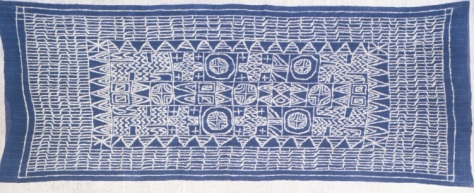Maps are everywhere today, but did you know that cartography, or the art of map-making, has existed in various forms since the dawn of humanity? The earliest known map was discovered in Turkey in 1963. It is a wall painting showing the layout of a village and two erupting volcanoes dating from approximately 6200 BCE; the map closely matches the ruins found in the nearby valley.

Map of gold mines in the New Kingdom of Egypt, ca 1160 BCE. These maps, drawn on papyrus show the location of gold mines and rock quarries. Annotation in hieratic, the common language, indicate the meaning of colors and symbols such as mountains, roads and rivers. This map is also considered one of the oldest geologic maps as the coloration matches the types of rocks found in the area. Source: http://www.wikipedia.org
Many early traditions passed knowledge on through story or movement, similar to how we give directions today, “turn left at the store and you’ll see my house behind the pine tree.” India has a rich history of such ‘verbal cartography’. The epic, the Mahabharata, details the surrounding landscape using text rather than drawings. An excerpt from the Mahabharata describes King Bharata’s kingdom, “There are seven Main Mountains…but thousands more mountains are recognized in their general vicinity…Then, there are other hills less well-known…the population drinks from many rivers: the great Ganges, the Indus and the Sarasvati.”

Ephemeral, or temporary, maps, made by drawing on the ground, are found around the world. Imagine the person you are giving directions to is confused, so you draw the store, the road, your house and the pine tree. In 1817, the Russian explorer Otto von Kotzebue visited the Marshall Islands. There, a local navigator laid out the location of all known islands in the chain using pieces of coral. By recreating this map for navigators on other islands, von Kotzebue was able to create a nearly complete map of the Marshall Islands. Pacific Islanders were well known for their ability to create mental maps. Sailors would memorize island locations in relation to the stars and sail for days at a time without a physical map.

Native Americans frequently made maps on birch bark. During the Revolutionary War, Benedict Arnold found one such map near the British garrison at Quebec. It was inserted into a split stick and pointing toward the western stream in a fork. When opened, the map included the streams, hunting camps, and a line showing a direction of travel.
During the age of European exploration, many traditional forms of mapping were replaced by the western method: using latitude and longitude to plot features on a grid. By the 1850s, mapping practices had become uniform across Europe and Asia. These methods eventually spread around the world. Today, most maps are created on computers, using Geographic Information Systems, or GIS. While maps may be easier to produce, they still require the careful eye of a cartographer to make sure they are easy to use and read.
Maps are everywhere now: on our phones, in our cars, on the trail. On-line versions can give us directions, link us to photos or restaurants, and even show us nearby parks to visit. There are over 90 State Park maps available for download to Android and iOS Apple mobile devices through Avenza.
Given the long history of cartography, it is exciting to think about what the future holds for mapping.
Post by Maddy Gold, former Student Conservation Association member
Source: Harley, J. B., and David Woodward, eds. The History of Cartography. Vol. 1-3. Chicago: U of Chicago, 1987-2007. Web. http://www.press.uchicago.edu/books/HOC/index.html.

